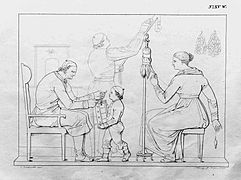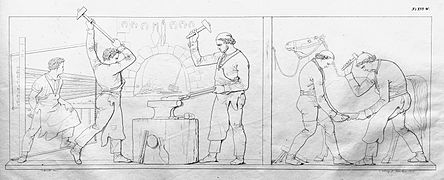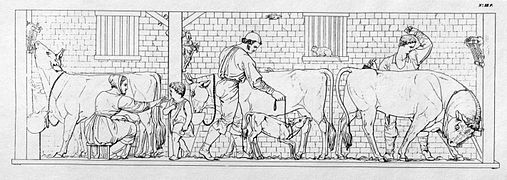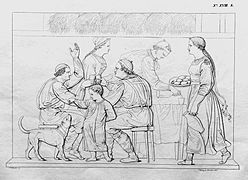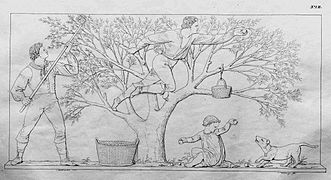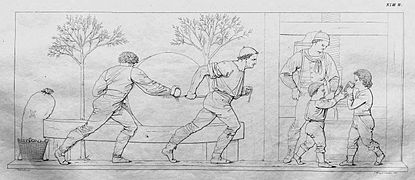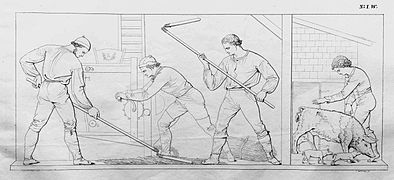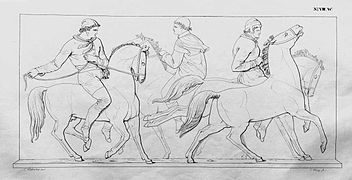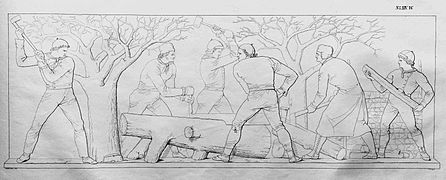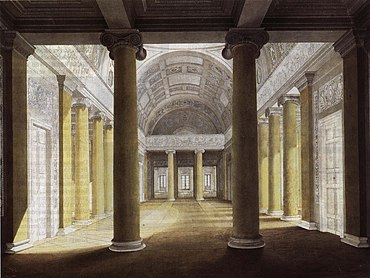Four season frieze
| Four season frieze | |
|---|---|
| Surname | The four seasons (four seasons frieze) |
| Artist | Conrad Weitbrecht |
| Location | Stuttgart, Rosenstein Castle , pillared hall |
| Year of origin | 1826-1828 |
| Art | Flat relief frieze |
| motive | 38 scenes from rural life in the course of the seasons |
| material | plaster |
| Dimensions | Length 65.3 m, height 0.97 m |
| Coordinates | 48.80052 ° N , 9.206 ° O |
The four seasons frieze is a flat relief frieze in the portico of Rosenstein Castle in Stuttgart. The frieze created by Conrad Weitbrecht in 1826–1828 shows 38 genre scenes from rural life over the course of the seasons.
Location
The four seasons frieze is installed in the central nave of the pillared hall (formerly the ballroom) of Rosenstein Castle in Stuttgart. This central room of the palace adjoins the foyer and the former dining room in the middle wing on the narrow sides. On the long sides, the columned hall is enclosed by the two former inner courtyards of the outer wing, today's whale hall and the elephant hall.
The architrave is supported by six Ionic columns that separate the central nave from the side aisles, and two Ionic columns on each of the narrow sides. The four seasons frieze is attached above. The almost one meter high frieze has a total length of around 65 meters, which is 25 meters on the long sides and 7.5 meters on the narrow sides.
description
Conrad Weitbrecht designed the plaster frieze at the same time as a graphic cycle between 1826 and 1828. The frieze is composed of 38 individual images that show genre scenes from rural life over the course of the seasons. The realistic scenes, in which there are around 160 human figures and 80 animal drawings, unfold in front of the viewer a panorama of rural life with images from the areas of cattle breeding, cattle market, horse market, viticulture, agriculture, fruit growing, horticulture, handicrafts, leisure activities, and rural festivals and domestic life.
The graphic cycle consists of 70 sheets. Most of the essential elements of the scenes in the frieze correspond to those of the corresponding sheets of the graphic cycle. In some cases, figures have also been left out in the frieze, and in one case two sheets of the cycle were combined into one scene.
Single scenes
The numbering of the individual scenes in the frieze in the following gallery begins on the side of the former dining room, with the scenes numbered from 1 to 38 clockwise. The corner points of the frieze are provided with the corresponding numbers for better orientation in the ground floor plan . In the gallery, the vertical subtitles Speisesaal, Elefantensaal, Foyer and Walsaal denote the sections of the frieze that are adjacent to these rooms.
The Stuttgart librarian and art writer August Wintterlin noted in an essay on Conrad Weitbrecht in 1896:
- "There is much more to complain about our work that we do not have a photographic reproduction of the entire frieze."
This remark continues to apply to the present article. In the absence of photos, we are showing the lithographs of the graphic cycle , which largely correspond to the original drafts and were published by Weitbrecht from 1829 one year after the friezes were attached.
history
Conrad Weitbrecht
Born in 1796, Conrad Weitbrecht attended as a teenager from 1813 for two years the private school of the famous Stuttgart sculptor Johann Heinrich Dannecker and then the academies in Milan and Florence. From 1818 to 1823 he was employed as an engraver in the silver goods factory Peter Bruckmann & Sons in Heilbronn . Even during his apprenticeship at the academies, the “thrashing on mythological ground” of the classicist fashion trend aroused Weitbrecht's displeasure. In Heilbronn he found ample material from popular life, which he now made the subject of his free artistic work. In the years 1818–1822 he drew a cycle of the seasons, on the basis of which the four-season frieze and the graphic cycle were later created.
From 1824 Weitbrecht worked as a draftsman, modeler and chaser in the royal ironworks in Wasseralfingen . A year later, in 1825, King Wilhelm appointed him inspector due to his outstanding achievements. Weitbrecht also frequently used genre motifs for his work in the iron foundry , the actors of which were classically-looking putti and geniuses, but which those who were not familiar with mythology could also simply view them as “lovely children's figures” and little angels.
Frieze
King Wilhelm, the “King of the Farmers” and horse lover, was enthusiastic about Weitbrecht's 1818–1822 cycle of seasons and found that the drawings would be ideal as a template for a frieze on his “Landhaus” Rosenstein, which was under construction. The genre scenes of the frieze also went well with the 16 round medallions with genius figures by Theodor Wagner , which were attached in pairs over the eight side porticos to the attic frieze . At the end of 1825, King Wilhelm commissioned Weitbrecht to carry out the frieze. He began modeling in April 1826, which he carried out on his own, and from September onwards with molding the clay models and pouring them in plaster, with an able assistant at his side. The transport of the heavy-weight frieze panels from Wasseralfingen to Stuttgart dragged on for a year, so that the panels were only ready in Stuttgart in November 1827. In May 1828 Weitbrecht was able to report to the king that his mandate had been fulfilled and that the two-year deadline had been met. King Wilhelm was very pleased with Weitbrecht's work. As a reward, he granted him a year of leave for further training in Italy while maintaining his salary and with a bonus of 1000 guilders.
In the Second World War in 1944, large parts were destroyed by Rosenstein Palace. The portico was preserved and the four seasons frieze was only slightly damaged. Until its restoration in 1956/1957, however, it suffered further damage, but was then properly restored by the Stuttgart sculptor Julius Frick (1884–1964). In 1963 cauliflower-like efflorescence from the plaster of paris, which was deficient for the time, had to be removed from the frieze. Today the frieze is a highlight of Rosenstein Castle, which incidentally lost most of its artistic interior decoration in the Second World War. As in the 19th century, the poor lighting of the frieze is to be criticized, so that the reliefs cannot fully develop their effect due to the dullness of the plaster.
Graphics cycle
At the same time as the designs for the frieze, Weitbrecht created drawings for a season cycle that contained almost twice as many sheets (70) as frieze scenes (38). As with the frieze designs, he went back to his cycle of the seasons, which had been created as early as 1818–1822. Weitbrecht had the drawings lithographed by Carl Heinrich Wenng , who was professor of drawing at the Royal Lithographic Institute in Stuttgart from 1816 to 1827 and then went to Munich. Weitbrecht was very satisfied with Wenng's work. The individual sheets have a number at the top right consisting of the first letter of the season and a consecutive Roman number (example: F VII = spring, lithograph no. 7) and are labeled “Weitbrecht inv.” At the bottom left and the lithographer's signature on the right "Wenng sc. Munich 1828" (instead of "sc.", "Gr." Or "engraved" can be used).
In 1829 the first two double issues (with spring and summer) came out at the Cotta'schen Verlagsbuchhandlung in Stuttgart, in 1833 the two double issues 3 and 4 (with autumn and winter). A portfolio with all 70 sheets and a title page (see illustration) was also published and later an edition in book form as a large horizontal volume, also with a title page. An eight-page booklet was used to explain the spring and summer scenes; the corresponding booklet is missing for the other two seasons.
reception
The important painting collector and art historian Sulpiz Boisserée , who lived in Stuttgart from 1819–1827 and exhibited his famous old German painting collection there, had the opportunity in the spring of 1826 to inspect the cycle of seasons designed by Weitbrecht from 1818–1822 and wrote enthusiastically to Goethe:
“These days I was given a great pleasure by the drawings of a young man employed by the local iron foundry, called Weitbrecht. This young man, out of his own pleasure, composed the history of the seasons in a very varied series as a bas-relief with as much invention, naivety, liveliness, grace and purity as I have hardly seen anything of recent art. This beautiful talent also met a happy moment; since the drawing pleases everyone, the king has it carried out in the large hall of his pleasure palace Rosenstein in Gyps. "
After the frieze was completed, the Württemberg priest and art critic Karl Grüneisen published a detailed description in the art paper of the Morgenblatt for educated estates , in which he emphasized the ancient spirit of the work and the faithful representation of rural life:
“It [Weitbrecht's work] is very peculiar, a true picture of the rural present. In its external form, it approaches the ancient world only by chance, provided that in both each appearance takes on a beautiful and harmonious shape, and provided that the permitted refinement of the modern costume leads involuntarily to the resemblance of the representations of Greek and Roman sculpture. … Weitbrecht has delivered a national work in the ancient spirit, in a lively understanding of the appearing life, in which the active industry, the strong loyalty and jovial manner of the Württemberg people are reflected. "
In his History of German Art , published in 1890, the influential art historian Wilhelm Lübke dedicated Weitbrecht's main work an appreciative mention:
“Konrad Weitbrecht (1796–1837) stood out among the students of Dannecker. As a modeller of the ironworks in Wasseralfingen, he was so outstanding with his excellent work that he was commissioned to decorate the royal pleasure palace Rosenstein with a frieze of the four seasons. Here he described the Swabian country life with a lovable, naive feeling for nature in the various seasons with a delicious abundance of graceful features. "
The Stuttgart librarian and art writer August Wintterlin remarked in 1896 in a biographical essay on Weitbrecht about the four seasons frieze:
"Anyone who has seen the frieze on the Rosenstein will gladly agree if we count this work among the best of its kind in modern art."
"Above all, there is such a lively and secure conception of rural life as only an artist could have, who from childhood on was in the middle of it and while working himself not far from it."
"What he had not been able to learn from any of his teachers, the secret of the frieze composition, the young artist took from the best example that existed at the time, the pageant of the Panathenae on the frieze of the Parthenon in Athens by Phidias ."
“Supported by a rich imagination, he made the partial composition, the grouping, particularly important. Almost all of the scenes on this frieze can be performed as patterns of happily placed, harmoniously structured on the inside and well connected on the outside, whose ever-changing basic shapes in themselves give the whole a wonderful life. "
Apart from his main work, the Four Seasons Frieze, Weitbrecht remained largely unknown despite his original departure from pure classicism and his turn to popular genre themes. This may also be due to the fact that Weitbrecht's sculptural work was essentially limited to the Rosenstein frieze, while other cycles were only available in drawings and were not sculpted. August Wintterlin believes that the frieze would have attracted more attention and had a more glamorous effect if it had been made in fine marble instead of dull plaster. Even the extensive graphic work does not seem to have contributed too much to Weitbrecht's fame. Probably a different fate would have been destined for him as a painter or with a larger sculptural oeuvre .
literature
- Karl Grüneisen : About the works of art of the royal country house Rosenstein near Stuttgart. In: Morgenblatt für educated stands, Kunst-Blatt 11.1830, pp. 289–308, here: 293–294, digi.ub.uni-heidelberg.de .
- Wilhelm Lübke : History of German art from the earliest times to the present. Stuttgart 1890, archive.org .
- Adolf Schahl: The good country. Life and work in Wuerttemberg in the cyclical series of pictures by Konrad Weitbrecht (1796-1836). Stuttgart 1980.
- Hans Otto Schaller: Georg Konrad Weitbrecht 1796–1836. In: Kunst und Künstler 10.1912, pp. 595–601, here: 596–597; digizeitschriften.de
- Hans Otto Schaller: To the calendar pictures by Georg Konrad Weitbrecht. In: From Swabian plaice. Calendar for Swabian Literature and Art 1916, pp. 85–89.
- Ernst Eberhard Friedrich von Seyffer : The royal country house Rosenstein . In: Württembergische Jahrbücher für patriotic history, geography, statistics and topography , 1830, pp. 307–360, here: pp. 345–348.
- Ernst Eberhard Friedrich von Seyffer : Description of the royal country house Rosenstein. Stuttgart 1831, pp. 45-48, Textarchiv - Internet Archive . - Reprint from #Seyffer 1830 .
- Manfred Warth (text); Rotraud Harling (photos): Rosenstein Castle and Park. The reliefs and sculptures at Rosenstein Castle and in Rosenstein Park in Stuttgart. By Rotraud Harling and Manfred Warth, Stuttgart. With 8 color pictures and 63 black-and-white illustrations. Stuttgart 1993, pp. 8, 13, Figures 45-55.
- Conrad Weitbrecht : The four seasons. A series of rural representations, composed and mostly executed in bas-relief as a frieze in the royal Württemberg country house Rosenstein by Konrad Weitbrecht. Stuttgart [circa 1850].
- August Wintterlin : The sculptor Georg Konrad Weitbrecht. A contribution to the history of the Württemberg arts and crafts 1796–1836. [Stuttgart 1896], pp. 14-17. - Special reprint from: Württemberg quarterly books for regional history , new series, 5.1896.
Web links
Footnotes
- ↑ #Wintterlin 1896 , p. 14.
- ↑ #Wintterlin 1896 , p. 17.
- ↑ #Wintterlin 1896 , p. 15.
- ↑ Relief: a female figure is missing on the right.
- ↑ Relief: smooth wall instead of brick structure.
- ↑ hay = haymaking.
- ↑ Relief: tree on the right is missing.
- ↑ Sickle handle = harvest festival after the harvest has been brought in (the sickle was hung up / hung in the framework of the barn).
- ↑ Relief: HI + H II combined.
- ↑ Relief: HI + H II combined.
- ↑ Relief: trough and wheel are missing. - Wergeltrog = trough for chopping the cider fruit by rolling a stone wheel, cider trot = cider press.
- ↑ Relief: the male figure on the left, the woman looking backwards in the middle and the two female figures on the right are missing.
- ↑ Relief: right half of the picture is missing.
- ↑ Relief: mirrored horizontally.
- ↑ Relief: right half of the picture is missing.
- ↑ Relief: right half of the picture is missing.
- ↑ Relief: male figure missing on the right.
- ↑ Relief: kneeling woman and man chopping on the left are missing, and on the right there is also a woman carrying a basket on her head.
- ↑ Relief: egging farmer with 2 oxen missing.
- ↑ #Wintterlin 1896 , pp. 2-4.
- ↑ #Wintterlin 1896 , pp. 6-8.
- ↑ # Schahl 1980 , p. 124.
- ↑ #Wintterlin 1896 , pp. 9-14.
- ↑ #Wintterlin 1896 , p. 15.
- ↑ # Schahl 1980 , pp. 26-28.
- ↑ Weitbrecht was employed in 1823 with an annual salary of 800 guilders ( #Wintterlin 1896 , p. 10).
- ↑ #Wintterlin 1896 , p. 15.
- ↑ # Schahl 1980 , pp. 28-29.
- ↑ #Wintterlin 1896 , p. 17.
- ↑ #Wintterlin 1896 , pp. 35-36.
- ↑ #Wintterlin 1896 , p. 37. - inv. = Invenit (invented), sc. = Sculpsit (engraved), gr. = Engraved.
- ↑ # Schahl 1980 , pp. 33-38. - Book version = #Weitbrecht 1850 . The transverse foil tape was approximately 67 cm wide and 48 cm high.
- ↑ # Schahl 1980 , pp. 19-20.
- ↑ # Grüneisen 1830 , p. 294.
- ↑ # Lübke 1890 , p. 882.
- ↑ #Wintterlin 1896 , p. 16.
- ↑ #Wintterlin 1896 , p. 17.
Coordinates: 48 ° 48 ′ 1.9 ″ N , 9 ° 12 ′ 21.6 ″ E



